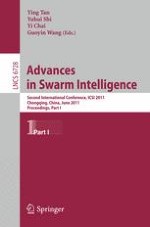The two-volume set (LNCS 6728 and 6729) constitutes the refereed proceedings of the International Conference on Swarm Intelligence, ICSI 2011, held in Chongqing, China, in June 2011. The 143 revised full papers presented were carefully reviewed and selected from 298 submissions. The papers are organized in topical sections on theoretical analysis of swarm intelligence algorithms, particle swarm optimization, applications of pso algorithms, ant colony optimization algorithms, bee colony algorithms, novel swarm-based optimization algorithms, artificial immune system, differential evolution, neural networks, genetic algorithms, evolutionary computation, fuzzy methods, and hybrid algorithms - for part I. Topics addressed in part II are such as multi-objective optimization algorithms, multi-robot, swarm-robot, and multi-agent systems, data mining methods, machine learning methods, feature selection algorithms, pattern recognition methods, intelligent control, other optimization algorithms and applications, data fusion and swarm intelligence, as well as fish school search - foundations and applications.
